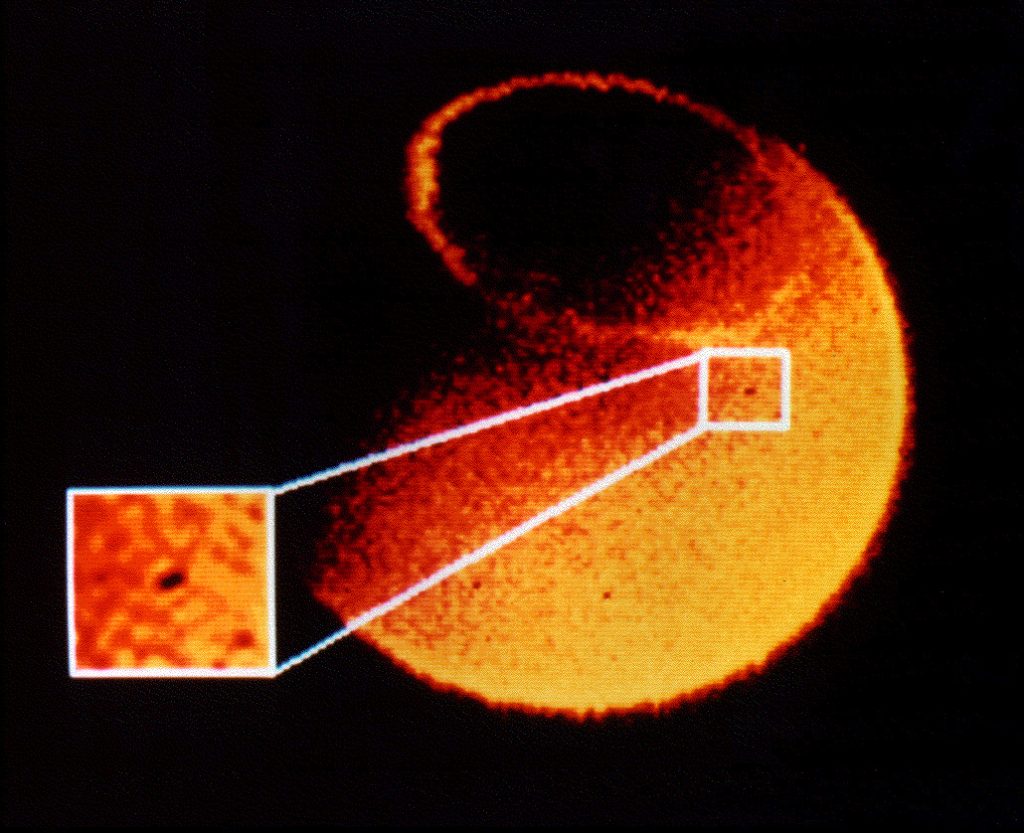
Download 150dpi JPEG image, ‘discover.jpg’, 608K
ALBUQUERQUE, N.M. — A Sandia National Laboratories physicist and his Texas-based research colleague have done some calculations that may offer additional insight into a decade-old astronomical controversy about whether up to 30,000 house-sized snowballs, or icy comets, are striking Earth each day.
That theory has been proffered by two space scientists, Louis Frank and John Sigwarth of the University of Iowa, based on observations by the Dynamics Explorer-1 satellite of transient dark spots, or holes, in the upper atmosphere’s far-ultraviolet dayglow emission.
Such a tremendous influx of small comets has never been observed. These water-bearing objects would add phenomenal quantities of water to Earth. If this could indeed be shown to be happening, much of what is known about comet creation and the origins of the oceans, terrestrial life, and perhaps even of the solar system might need revision.
The interpretations have been met with much scientific skepticism, but Frank and Sigwarth weighed in last May with more evidence — observations by the NASA satellite Polar that they said provide new support for the existence of the dark holes. A number of former critics became converts.
Now, however, Sandia physicist Mark Boslough and Randy Gladstone of the Southwest Research Institute in San Antonio, Tex., have published a study that provides a less provocative — but still scientifically interesting — explanation for the so-called atmospheric holes.
They may be plumes, not holes, and meteoroids may be the source.
Their computational simulations, which make use of Sandia’s shock physics code CTH and Boslough’s earlier work with Sandia colleague Dave Crawford in successfully predicting the visible plumes from Comet Shoemaker-Levy 9’s impact into Jupiter in 1994, suggest that the entry of ordinary meteoroids can form dark spots very similar to those reportedly observed by the satellite instruments.
Their study is published in the Dec. 15 Geophysical Research Letters, along with four other studies by other scientists that together the journal say provide “five independent tracks of evidence that are entirely inconsistent with a huge bombardment by small comets.” The journal says the five studies together “refute this [the small comets] hypothesis.”
Boslough and Gladstone reject the assumption, central to the small comets hypothesis, that the observed darkening is caused by absorption of water vapor above the atmosphere. Instead, they believe that atomic oxygen, which is the source of the dayglow, is momentarily displaced by the passage of meteoroids. Normal air from lower altitudes contains oxygen in its molecular form and is black in the wavelength that the satellite sees.
They propose that when a stony object as small as 50 centimeters across collides with the atmosphere and plunges into the lower layers, it ejects a very thin plume of this “black” air to as high as 1,000 kilometers. It is these dark plumes, they suggest, that are being detected by the satellites.
Their work is preliminary and they acknowledge that the hypothesis doesn’t account for the observed high rate of dark hole formation. But they say if they can show their idea is correct for large meteoroids, they will look into the possibility that small ones have a similar effect.
The two scientists also propose a test of their hypothesis. They say if they are right, it is just a matter of time before Department of Defense satellites detect an infrared flash from a large meteor that corresponds exactly to the time and location of one of the holes.
“We expect that satellite data on atmospheric holes in the FUV [far ultraviolet] will confirm the existence of [high-altitude] plumes that are continuously being generated by meteors.”
The four other new papers that also undermine the small comets hypothesis are based on lack of any evidence for frequent comet bombardment on the moon, no sign of the high abundance of noble gases in the upper atmosphere that would be expected from a high rate of comet bombardment, absence of visible light observations, and evidence that the source of dark pixels in the Polar spacecraft’s ultraviolet camera is internal to the camera system.
Three of these papers are by scientists at the Lunar and Planetary Laboratory at the University of Arizona, and one is by scientists at the Universities of Alabama and Washington and NASA Marshall Space Flight Center.
Frank and Sigwarth, however, still strongly stick to their small comets hypothesis — they particularly dispute that the dark spots are instrumental artifacts — and the controversy is likely to continue for some time.
Technical contact:
Mark Boslough, mbboslo@sandia.gov, (505) 845-8851